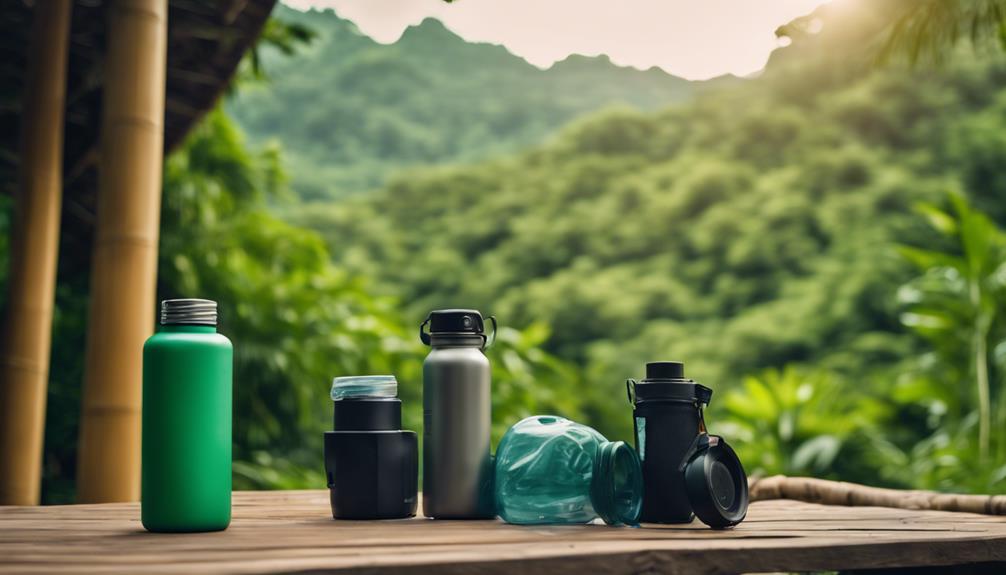You might think that having the right gear is only for seasoned adventurers, but that’s where you’re mistaken. ‘Adventure Gear Essentials: The Complete Guide for Every Thrill Seeker‘ is your roadmap to understanding and selecting the right gear for any outdoor escapade.
This guide leaves no stone unturned, from deciphering the maze of navigation tools to ensuring your boots are made for more than just walking. So, are you ready to step up your adventure game and explore the wild with confidence and safety?
Key Takeaways
1. Gear Selection Based on Specific Needs Before you pack your bags for an adventure, it’s crucial to evaluate the type of activity, the duration of your trip, and the terrain you’ll encounter.
This assessment helps in selecting the most suitable adventure gear. For instance, lightweight gear might be preferable for a long backpacking trip, while more robust equipment could be essential for mountain climbing.
2. Choosing the Right Clothing: Invest in moisture-wicking clothing to keep you dry and comfortable during intense activities.
The choice of base layers should also be tailored to the intensity of your activity—lighter materials for less strenuous activities and thermal, moisture-wicking fabrics for high-energy pursuits. This can significantly impact your comfort and performance.
3. Importance of Proper Outerwear When selecting outerwear, consider critical factors like insulation, water resistance, breathability, and mobility.
These attributes can dramatically affect your comfort and ability to move, especially in challenging environments. For example, a breathable yet waterproof jacket is ideal for activities in wet climates, ensuring you stay dry without overheating.
4. Footwear That Fits Adventure Footwear should be chosen for comfort, stability, and protection. Ensure that your shoes are well-fitted and suitable for the terrain you will encounter.
Whether waterproof hiking boots for rugged mountain trails or lighter shoes for beach walking, the proper footwear is critical for preventing injuries and enhancing travel performance.
5. Safety and Navigation Tools Do not overlook the importance of essential safety and navigation tools. Items like GPS devices, maps, compasses, and altimeters are crucial for keeping you on track. Depending on your activity, consider specialty gear like avalanche safety kits, high-altitude masks, or water filtration systems.
These tools are not just accessories but necessities that enhance safety and performance during various outdoor adventures.
Introduction to Adventure Gear
Understanding the essentials of adventure gear is your first step towards a safe and thrilling outdoor experience, as each piece of equipment, from multifunction tools to specialized cameras, plays a unique role in enhancing comfort, convenience, and safety during your journeys.
It’s essential to stay informed about gear materials as innovations and trends evolve. For instance, advancements in synthetic materials have led to lighter, more rigid, and more weather-resistant gear.
You might consider custom gear tailored to your specific needs. But, while the benefits are clear – perfect fit and functionality – there are drawbacks you shouldn’t overlook, including the often high cost and longer wait times for production.
Think about rental options, too. Renting can offer cost savings and convenience, particularly for infrequent adventurers or those trying out a new activity.
However, availability and quality can vary, and something must be said about the familiarity and fit of owning your gear.
Ultimately, the right gear can distinguish an unforgettable adventure from an uncomfortable ordeal. So invest time in understanding your gear needs. It’s an investment in your safety, comfort, and overall outdoor experience.
What is Adventure Gear? Definition and Importance
Now that you’ve got a grasp on the basics of adventure gear, let’s define what it truly is and why it’s so important for your outdoor expeditions.
Adventure gear, in its essence, is specialized equipment meant to guarantee your safety, comfort, and efficiency as you take on the wild. It’s not just about having fancy tools, but about investing in quality gear that can withstand nature’s harsh conditions.
Consider gear materials: durability vs. weight is a constant balancing act. You need gear that’s tough enough to handle extreme environments but light enough not to hold you back.
Custom gear can offer a tailored fit and functionality, but it comes with its own set of pros and cons. It can be expensive, and not all modifications may serve you in the long run.
However, don’t be disheartened if you’re on a budget. There are DIY alternatives available that can be both budget-friendly and dependable. Just remember, the right gear doesn’t just enhance your adventure; it could also be a lifesaver. So, understanding your gear isn’t an option; it’s necessary.
Choosing the Right Gear for Your Adventure: Factors to Consider
Exploring the vast world of adventure gear can feel overwhelming, but honing in on key factors like your chosen activity, trip duration, terrain and weather conditions, as well as the weight and quality of the gear, can greatly streamline your selection process.
Different adventures require specific gear. For instance, the lightweight windbreaker perfect for a summer hike won’t cut it on a winter camping trip. Always consider the terrain and climate of your destination.
Trip duration also impacts your gear selection. Longer trips need durable, reliable equipment. Learn and follow gear longevity best practices to make certain your gear lasts.
Weight is another vital factor. Heavier gear can slow you down, so opt for lightweight, high-performance alternatives.
Quality shouldn’t be compromised for cost. However, there are budget-friendly options that don’t sacrifice performance. Research and find affordable gear alternatives that meet your needs.
Lastly, as an adventurer, you’re a steward of the environment. Choose eco-friendly gear when possible. Sustainable choices reduce your carbon footprint and support companies committed to responsible practices. You’ll choose the right gear for your adventure by considering these factors.
Overview of the Guide: What You Will Learn
Exploring this guide, you’ll uncover the essentials of adventure gear, from advanced cameras capable of capturing your thrilling exploits to durable footwear designed to withstand the most rugged terrains. You’ll learn the importance of gear maintenance, ensuring that your equipment performs at its best every time you set foot on a new adventure.
You’ll also immerse yourself in the exciting world of adventure photography. This guide will equip you with the knowledge to choose the right camera and accessories that will help you immortalize your outdoor escapades in stunning detail.
Outdoor cooking is another key aspect that this guide will cover. You’ll learn about compact, efficient cooking systems that will allow you to prepare hearty meals in the wilderness.
Below is a snapshot of what you’ll learn in this all-encompassing guide:
| Topic | What You’ll Learn |
|---|---|
| Gear Maintenance | How to keep your gear in top condition |
| Adventure Photography | Choosing the right camera and accessories |
| Outdoor Cooking | Efficient, compact cooking systems for the wilderness |
| Essential Gear | From cameras to footwear, the must-haves for every adventurer |
Essential Clothing for Adventure Travel
When planning your adventure travel wardrobe, it’s essential to prioritize moisture-wicking clothing that will keep you dry and comfortable during rigorous physical activities.
Performance fabrics, designed with sweat management in mind, are vital to this. They function by moving sweat away from your skin to the outer surface of the material where it can evaporate quickly.
The advantage of these high-tech materials is that they allow for efficient sweat management, keeping you cool when it’s hot and warm when it’s colder.
Combining these with quick-drying essentials can make a world of difference in your adventure journey. Quick-drying clothing reduces the overall weight of your backpack. It ensures you’re never left in wet clothes for long, which could lead to discomfort or hypothermia in extreme cases.
Materials like nylon and polyester are your best bet here. They’re lightweight, durable, and dry much faster than cotton. Investing in the right kind of clothing sets you up for a successful and enjoyable adventure. After all, the more comfortable you are, the more you’ll be able to focus on the thrill of the journey.
Base Layers: Importance and Best Materials
Understanding the importance of base layers and knowing the best materials for them can significantly enhance your comfort and performance during adventure activities.
Base layers are the foundation of your adventure outfit and play a critical role in regulating your body temperature and managing moisture. Whether you’re hiking up a stormy mountain or kayaking in tranquil waters, they keep you warm when it’s cool and cool when it’s warm.
Merino wool and synthetic materials like polyester and nylon are the go-to choices for base layers. The critical difference between Merino and Synthetic lies in their moisture management and odor resistance.
Merino, a natural fiber, excels in breathability and odor-resistant properties, making it ideal for prolonged wear. Conversely, synthetic materials dry quickly, providing excellent moisture control, especially for high-intensity activities.
Ultimately, the choice between merino and synthetic depends on your adventure’s nature and intensity. For instance, in cold and less intense activities, merino might be your best bet.
However, you might lean towards synthetic for high-sweat activities because of its superior quick-drying features. Either way, selecting the suitable base layer material will guarantee a more comfortable and enjoyable adventure experience.
Outerwear: Types and Selection Criteria
Choosing the right outerwear can make or break your adventure experience, so it’s essential to understand the different types available and the criteria for selecting the most suitable ones.
In the domain of adventure gear, outerwear includes jackets, pants, and base layers, each designed for specific activities and environmental conditions.
Mastering layering techniques is critical. Your base layer should regulate body temperature and wick away moisture, while the outer layer protects from the elements.
Remember that your outerwear needs to strike a balance between breathability and insulation. Too much breathability can lead to heat loss, while over-insulation can cause overheating.
Jackets with synthetic or down filling offer warmth but vary in weight and compressibility.
The waterproof vs. water-resistant debate is essential. Waterproof jackets, equipped with technologies like Gore-Tex, shield you from rain and snow while allowing moisture to escape. Water-resistant items, though, only offer temporary protection against light rain.
In essence, selecting the right outerwear involves considering your activity, environment, and personal comfort. Remember, the goal is to enjoy your adventure; the right gear can make that a reality.
Footwear: Choosing the Right Boots and Shoes
Exploring the vast world of adventure footwear, you’ll find that the proper boots and shoes are as critical as any other piece of your gear, impacting your comfort, safety, and overall experience on the trails.
Boot fitting is paramount. A well-fitted boot provides stability, supports your ankles, and prevents blisters. A protective toe cap and heel counter add durability and resistance against rocky trails.
Terrain compatibility should guide your choice. Hiking boots with Vibram soles offer superior grip and traction on rough terrains, while lightweight trail running shoes are perfect for fast-paced adventures.
Waterproofing technology, such as a Gore-Tex lining, guarantees your feet stay dry in wet conditions while allowing breathability. But remember, not all adventures call for waterproof boots. Sometimes, a breathable, quick-drying shoe is more suitable.
Ultimately, your adventure footwear should balance comfort, protection, and adaptability to your activity’s demands. Whether walking a gentle trail or conquering rugged mountains, the proper footwear can make or break your adventure.
In this community of thrill-seekers, you’re not alone in your quest for the perfect boots and shoes. Let’s continue to explore together.
Specialty Gear for Different Activities
Venturing into specific activities like rock climbing, scuba diving, snowboarding, backpacking, or mountain biking calls for specialized gear tailored to enhance safety, performance, and enjoyment in each unique environment.
To illustrate, consider the following table:
| Activity | Essential Gear | Purpose |
|---|---|---|
| Rock Climbing | Climbing equipment (Harnesses, ropes, carabiners, climbing shoes) | Promotes safety and enhances climbing performance |
| Scuba Diving | Scuba essentials (Wetsuits, masks, fins, regulators) | Necessary for underwater breathing, vision, and mobility |
| Snowboarding | Snowboarding gear (Snowboards, bindings, boots, helmets) | Provides control, safety, and comfort during descents |
| Backpacking | Backpacks, sleeping bags, stoves, trekking poles | Enables multi-day trips with comfort and convenience |
| Mountain Biking | Helmets, gloves, hydration packs, knee pads | Promotes safety and hydration during off-road cycling |
Your choice of gear should be meticulous. Research thoroughly, read reviews, and, if possible, test before you buy. The right gear doesn’t just enhance your experience; it also keeps you safe. Remember, you’re not just a thrill-seeker but also a part of a community that values safety, performance, and the sheer joy of adventure.
Hiking and Backpacking: Essential Gear List
When gearing up for a hiking or backpacking trip, it’s vital to equip yourself with a list of essentials, starting with proper hiking boots. These boots offer excellent ankle support and traction to prevent injuries on uneven terrain. Remember, your boots aren’t just foot coverings, they’re your trusty partners on every rocky, muddy or slippery path you’ll traverse.
Your backpack is your mobile home. It should be lightweight and durable, with adjustable straps and compartments for easy organization. This is where your camping essentials and survival gear stash reside. Pack wisely, and make sure every item has its place and purpose.
Don’t forget your trekking poles. They’re not just for the elderly or the unstable. Poles provide stability, reduce strain on joints, and improve balance during long hikes, making them a worthwhile addition to your gear.
Clothing comes next. Opt for a high-quality, moisture-wicking fabric that keeps you dry and comfortable. Synthetic materials or merino wool are excellent choices.
Lastly, don’t overlook your trail snacks. Energy bars, nuts, dried fruits – these are your fuel on the trail. And of course, always carry navigation tools. A topographic map, compass, and GPS device are non-negotiables. They’re your lifeline in the wilderness, leading you safely home.
Water Sports: Gear for Kayaking, Rafting, and Diving
Shifting gears from hiking and backpacking, let’s get our feet wet with water sports, discussing the necessary gear for activities such as kayaking, rafting, and diving.
Your kayak accessories should include essential must-haves like waterproof dry bags. These bags protect your belongings from water damage during your adventure. A personal flotation device (PFD) is also critical equipment, providing buoyancy to ensure you stay afloat.
Our top recommendation for rafting gear is a quality PFD, as safety should be your number one priority. Don’t forget a good helmet to safeguard your head from unforeseen bumps and knocks.
Now, let’s plunge into the essentials for underwater exploration. A mask with a tempered glass lens is a must-pack item. It offers clear vision, allowing you to enjoy the vibrant underwater life. To maintain your body temperature and protect your skin, a neoprene wetsuit is essential.
Lastly, a waterproof camera should be considered for all these activities. It’s not strictly necessary for safety but lets you capture and relive your thrilling experiences.
Winter Sports: Essentials for Skiing and Snowboarding
Plunging into the exhilarating world of winter sports, you’ll find that the right equipment, from insulated gloves to anti-fog goggles, is critical to your performance and safety while skiing or snowboarding.
These essentials protect you from the elements and mitigate the risk of winter sports injuries.
Perfecting skiing techniques requires practice and gear tailored to your needs. Layering properly, with moisture-wicking base layers, insulating mid-layers, and waterproof outer shells, helps you maintain an ideal body temperature, enhancing your endurance on the slopes.
When it comes to snowboarding, maintenance of your board is essential. A well-kept board guarantees smoother rides and increases your control, reducing the chances of mishaps.
Moreover, don’t underestimate the importance of a good helmet. Helmets with impact-absorbing technology safeguard you during high-speed falls, a common cause of winter sports injuries.
Lastly, for backcountry enthusiasts, avalanche safety gear like beacons, probes, and shovels is a necessity. These tools equip you to respond effectively to emergencies, making your thrilling escapades safer.
In essence, the right gear amplifies your performance and ensures you return from the slopes injury-free, ready for the next adventure.
Safety and Navigation Tools
Exploring unfamiliar terrains and facing unexpected challenges becomes less intimidating when equipped with essential safety and navigation tools.
Knowledge of survival techniques is essential; however, having the right gear enhances your ability to respond effectively to emergencies.
Emergency signaling equipment, for instance, is a lifeline when you’re lost or in danger. Flares, whistles, and mirrors can attract attention and accelerate rescue efforts.
Similarly, a reliable multi-tool kit can aid in unexpected situations, from gear repair to food preparation.
Route planning is another critical aspect of your adventure. A detailed plan helps you anticipate challenges and plan for contingencies. Remember, your plan should be flexible to accommodate changes due to weather or terrain.
Safety and navigation tools aren’t just about ensuring you can find your way. They’re about guaranteeing that you’re prepared for whatever comes your way.
Whether you’re a weekend hiker or a seasoned mountaineer, investing in these tools isn’t just a smart move—it’s a commitment to your safety.
In adventure, being well-prepared is the best way to belong. So gear up and step confidently into your next escapade, knowing you’re ready for whatever awaits.
Navigational Equipment: GPS Devices and Maps
Exploring the vast wilderness becomes less intimidating when you’re equipped with the right tools, such as GPS devices and maps, that offer invaluable assistance in pinpointing your location and tracking your journey. With these devices, you can confidently venture into new terrains, embracing the thrill of exploration while mitigating the risks of getting lost.
- GPS Accuracy and Map Integration: High-quality GPS devices provide accurate positioning, utilizing satellite navigation for precise location tracking. Integrated maps within these devices present a visual overview of your surroundings, enhancing your understanding of the terrain.
- Terrain Visualization: Detailed topographic maps allow for effective terrain visualization. You can identify elevation changes, landmarks, and potential challenges ahead, enabling better route planning and decision-making.
- Real-Time Tracking and Route Planning: Modern GPS devices offer real-time movement tracking, displaying waypoints and progress along your pre-planned route. With this feature, adjusting your path in response to unexpected obstacles or opportunities becomes more straightforward and safer.
As you navigate the wilderness, remember that your equipment, particularly navigational tools, is an essential partner in your adventure.
Be sure to choose devices that offer superior GPS accuracy, map integration, terrain visualization, and real-time tracking for a safer, more fulfilling journey.
Safety Gear: Helmets, Harnesses, and Protective Pads
When you’re ready for an adventure, don’t overlook the essential role of safety equipment – helmets, harnesses, and protective pads – in safeguarding you against potential injuries during high-risk activities.
A well-adjusted helmet fit is vital, protecting your head from severe injuries during biking, skiing, or climbing. Choose one that meets industry standards and offers a snug, comfortable fit, ensuring it doesn’t shift during your escapades.
Harness comfort is another critical factor, especially for activities like zip-lining or climbing. A well-fitted harness offers security and prevents falls, but it shouldn’t chafe or restrict your movements. Ensure it’s adjustable to your body shape and size for maximum comfort and safety.
Protective pads lessen the pad impact on your knees and elbows during activities like skateboarding or BMX biking. Investing in high-quality pads that fit correctly can distinguish between minor stumble and severe injuries.
Communication Devices: Satellite Phones and PLBs (Personal Locator Beacons)
Just as you wouldn’t overlook the importance of protective gear, it’s equally vital to contemplate the role of communication devices like satellite phones and Personal Locator Beacons (PLBs) in your adventure toolkit. In remote areas, where cellular network coverage is often non-existent, these tools aren’t just convenient—they can be life-saving.
When it comes to communication reliability, satellite phones are second to none. They provide global coverage and enable communication via voice calls, text messaging, and data services. They’re your lifeline to the outside world when you’re deep in the wilderness.
PLBs, on the other hand, are critical for emergency protocols. These devices transmit a distress signal to rescue services, pinpointing your location. Being registered with authorities, PLBs ensure a prompt response when time is of the essence.
Here’s why you need these devices:
- Satellite phones offer dependable communication in remote locations.
- PLBs initiate swift emergency response by sending a signal to rescue services.
- Both devices provide location tracking accuracy, which is a boon when exploring off-grid locations.
Equip yourself with these devices and venture confidently, knowing you’re prepared for any eventuality.
Weather Protection Gear
No matter where your adventures take you, having the correct weather protection gear is essential for maintaining comfort and safety during outdoor pursuits. Rainy-day essentials should be at the top of your packing list. A quality waterproof jacket with sealed seams is a must. This wet weather gear will keep you dry in the most torrential downpours.
But waterproof protection strategies don’t stop there. Your lower body needs safeguarding, too. Breathable rain pants are an excellent choice, allowing moisture to escape and preventing overheating.
Consider the table below, highlighting some essential weather protection gear:
| Gear | Purpose | Importance |
|---|---|---|
| Waterproof Jacket | Keep dry | Sealed seams for maximum protection |
| Breathable Rain Pants | Guard lower body | Allows moisture to escape |
| Waterproof Gloves | Dry, warm hands | Maintains dexterity and comfort |
| Lightweight Poncho | Quick protection | Useful for sudden weather changes |
| Sturdy Umbrella | Shield from elements | Versatile in various conditions |
Waterproofing: Choosing Waterproof Jackets and Pants
Braving the elements in wet conditions, you’ll find that selecting the right waterproof jackets and pants is essential to staying dry and comfortable during your adventures. An understanding of the latest waterproofing technology, innovations, and trends is a must.
Three key aspects worth exploring are:
- Material: Look for high-performance fabrics like Gore-Tex or eVent that offer excellent waterproofing and breathability.
- Design: Consider features like sealed seams, adjustable hoods, and waterproof zippers that enhance protection.
- Waterproof Rating: The higher the rating (measured in millimeters), the better the protection against heavy rain.
Eco-friendly waterproofing options are increasingly available as well. Brands are now offering gear made from recycled materials and using PFC-free waterproofing treatments, helping you to reduce your environmental footprint.
You can also extend the life of your gear using DIY waterproofing techniques. Regular reproofing with waterproofing solutions can maintain the effectiveness of your gear, making it a worthwhile part of your gear maintenance routine. With the proper knowledge and preparation, you can brave any weather condition without compromising comfort or sustainability.
Insulation: Staying Warm in Cold Conditions
In the heart of winter’s chill or atop an icy mountain, staying warm becomes crucial, and understanding the ins and outs of insulation can make the difference between a comfortable adventure and a frosty ordeal. You need to master insulation techniques and heat retention strategies, as well as select the right cold weather gear.
Layering is a crucial insulation technique. Start with a base layer of merino wool or synthetic fibers to trap heat and wick moisture away from your body.
This helps maintain your core temperature and keeps you dry. Next, add an insulated jacket or pants that provide extra warmth without restricting your movement.
Your extremities, often the first to feel the cold, need special attention. Hats, gloves, and socks made from insulating materials protect them from frostbite.
Understanding your gear’s temperature rating is crucial. It helps you choose the right clothing for varying cold climates and stay comfortable.
UV Protection: Sunglasses, Sunscreen, and Protective Clothing
While keeping warm in cold conditions is all about layering and insulation, protecting yourself from the sun’s harmful UV rays requires different gear, including sunglasses, sunscreen, and specific clothing. Your sun protection essentials must include these protective gear for the best UV defense strategies.
- Sunglasses: Choose shades with 100% UV protection to guard your eyes from damaging rays, preventing conditions like cataracts and macular degeneration.
- Sunscreen: A broad-spectrum sunscreen with an SPF of 30 or higher is essential. It shields your skin from UVA and UVB rays, reducing the risk of sunburn and skin cancer risk.
- Protective Clothing: Opt for clothes with a UPF rating. These provide an extra barrier against UV radiation, which is particularly important in intense sunlight.
Packing List for Various Adventure Types
Depending on the type of adventure you’re embarking on, your packing list will vary greatly; let’s explore what essential gear you should pack for various adventure activities.
When hiking, your survival essentials should include lightweight, moisture-wicking clothing, a sturdy backpack, trekking poles, and a portable water filter.
Gear organization becomes particularly significant on camping trips where you’ll need a high-quality tent, sleeping bag, stove, cookware, and a dependable headlamp.
For more extreme adventures, such as climbing, ensure your gear includes a harness, ropes, carabiners, climbing shoes, and a helmet for safety.
Water-based activities like kayaking or rafting call for a life jacket, waterproof dry bags, paddles, a rescue whistle, and quick-dry clothing.
Emergency preparedness is critical for winter adventures, requiring you to pack insulated layers, waterproof snow boots, hand warmers, a snow shovel, and an avalanche beacon.
Day Trips: Minimalist Packing List
Venturing out for a day trip requires bright and minimalist packing, ensuring you have all the survival essentials like water, snacks, a basic first aid kit, and a handy multi-tool packed in a lightweight backpack. Your goal is to be prepared for any situation without being weighed down by unnecessary gear.
In the spirit of emergency preparedness, here are three lightweight options you should consider:
- A portable water purification system: This small yet crucial tool guarantees access to clean drinking water, a survival essential.
- A compact shelter option: An emergency bivy sack or a lightweight tarp can be a lifesaver during unexpected weather changes.
- A compact or action camera: Capture memories without adding bulk to your pack.
Your day trip packing list should balance preparedness and minimalism. This approach allows you to enjoy the adventure without the burden of excess gear.
Remember, the right gear can enhance your experience and safety, while the wrong or excessive gear can turn an exhilarating adventure into an exhausting ordeal. So pack smart, stay light, and let the adventure begin!
Multi-Day Expeditions: Comprehensive Packing Considerations
When packing for multi-day expeditions, it’s important to consider both the weight and functionality of your gear, with a focus on essentials such as compact shelters, suitable sleeping bags, and portable water purification systems.
Gear organization is key; efficient packing means strategically storing items for easy accessibility and best weight distribution.
You’ll need lightweight, compact shelters like tents or bivy sacks. A high-quality sleeping bag suitable for the expedition’s temperature range can prevent hypothermia and guarantee a good night’s rest. Remember, you can’t haul gallons of water, so a portable water purification system is necessary.
Food preparation matters, so consider meal planning. Opt for lightweight, high-energy foods that are easy to cook. Think about nutritional needs to maintain your stamina.
Your pack should include a first aid kit for emergency response. This isn’t just band-aids and antiseptic; consider packing items like a splint, wound closure strips, and a multi-tool.
International Adventures: Special Considerations for Overseas Travel
Starting an international adventure requires thoughtful consideration of unique aspects such as voltage requirements, travel insurance, local customs, and visa necessities to guarantee a smooth and enriching experience.
Voltage compatibility guarantees that your electronic devices function correctly abroad. Additionally, securing travel insurance provides a safety net for unforeseen circumstances, ranging from medical emergencies to trip cancellations.
Being aware of local customs and mastering a few phrases in the local language will enrich your cultural experience and foster a sense of belonging. Being informed about visa requirements is equally essential to avoid any last-minute hitches.
To help you prepare for your overseas adventure, consider the following:
- Research voltage compatibility: Check your destination’s electrical outlets and voltage requirements.
- Secure travel insurance: This covers you in case of medical emergencies or trip cancellations.
- Understand local customs and visa requirements: Familiarize yourself with the local traditions and check visa necessities in advance.
Lastly, guarantee the secure storage of essential documents like your passport, travel itinerary, and emergency contacts. This way, you’ll have all the necessary details, ensuring a seamless adventure overseas.
Maintenance and Care of Adventure Gear
To keep your adventure gear in top shape, it’s essential to prioritize regular cleaning, thorough inspection, and proper storage. The importance of gear storage and organization can’t be overemphasized. Guarantee that your equipment is stored in a cool, dry place away from direct sunlight to prolong its lifespan and maintain performance.
Specific drying techniques are crucial when it comes to cleaning. After cleaning, thoroughly dry all gear to prevent mold and mildew, which can significantly degrade the quality and durability of your equipment. Remember to follow the manufacturer’s instructions meticulously for the best results.
Lastly, don’t forget about waterproofing. Your gear’s water resistance can diminish over time, so it’s critical to apply waterproofing treatments regularly. Numerous waterproofing tips and tricks are available, but always follow the recommendations from the gear manufacturer for optimum efficacy.
In essence, the longevity and performance of your gear lie in your hands. Proper maintenance and care aren’t only about preserving your investment and ensuring safety during thrilling adventures. Your gear is your companion in every journey; treat it well, and it’ll serve you exceptionally in return.
Frequently Asked Questions
What Is the Most Adrenaline Rush Activities?
You’ll find skydiving experiences, mountain climbing techniques, and whitewater rafting stories among the most adrenaline-pumping activities. Each offers a unique thrill, testing your physical strength, mental agility, and pushing your adventurous spirit to the limit.
What Makes Someone a Thrill Seeker?
You’re a thrill-seeker if your psychological motivations drive you to evaluate risks, conquer fears, and relentlessly pursue adrenaline-fueled experiences. Your spirit craves excitement, and your actions embody a fearless pursuit of the extraordinary.
Conclusion
So, you’ve journeyed with us through the vast world of adventure gear. But remember, knowledge is just the first step. Only the wild can genuinely test your preparedness. Will your gear hold up? Will it keep you safe, comfortable, and ready for the thrill?
The unknown is part of the adventure. Now, it’s your turn to gear up, step out, and embark on your epic story. The wilderness awaits… are you ready to answer the call?














